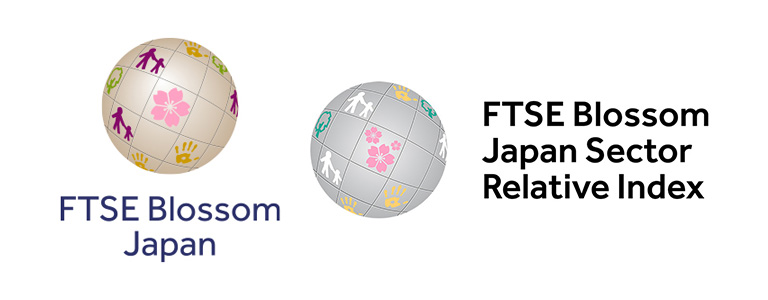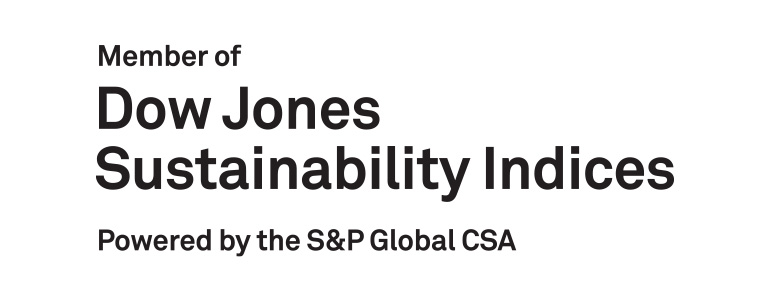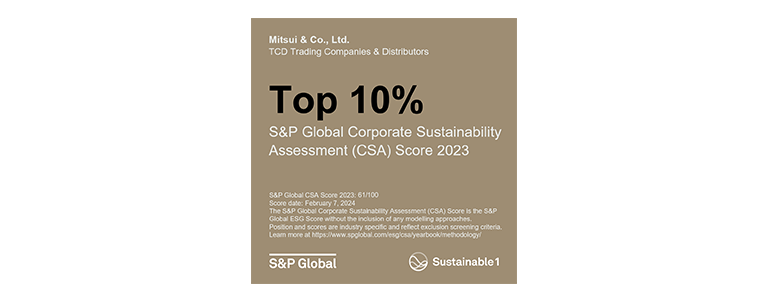Biodiversity
The LEAP approach to Mitsui's Forest
The LEAP Approach is recommended by the Taskforce on Nature-related Financial Disclosures (TNFD) as an integrated approach for identifying and assessing nature-related issues. In February 2024 we conducted a LEAP Approach analysis of Ishii Forest, in Hokkaido, Japan, one of Mitsui’s Forests in which we have achieved forest operations that enhance the value of natural capital. Through the LEAP Approach analysis process, we found that compared to other methods of forest management, the case in which we continue our current management practices in Ishii Forest would have a more positive impact in terms of biodiversity conservation and demonstrating the forest's public benefit values (carbon sequestration, soil runoff control, and groundwater recharge).
Mitsui’s Forests
One example of our efforts to conserve biodiversity in our business activities is our forestry business in Japan.
Mitsui & Co. owns forests in 75 locations in Japan, from Hokkaido in the north to Kyushu in the south. Mitsui's Forests cover a total area of approximately 45,000 hectares, which is equivalent to about 70% of the area of Tokyo's 23 wards, or 0.1% of Japan. Mitsui stably provides timber that accounts for about 0.1% (approximately 40,000 m3) of the annual demand for timber in Japan. In addition to the supply of timber, we practice sustainable forest management to ensure that they are properly protected and nurtured for the good of society. This involves a cycle of actively utilizing the benefits and functions they provide and then reinvesting the benefits earned back into forest resource conservation.
Mitsui Bussan Forest Co., Ltd., our wholly owned subsidiary, is responsible for the management of Mitsui’s Forests. Approximately 60 employees, including forest development experts, field workers engaged in on-site work, and an administrative department, work together to manage the vast forests that our predecessors have carefully preserved over the years.
Mitsui's Forests Operational and Management Initiatives
We have acquired international forest certification for Mitsui's forests and the company that manages them. Forest certification comprises forest management certification, which is third-party certification awarded to forests that are being managed appropriately, and chain of custody (CoC) certification, which certifies that timber from certified forests is being handled appropriately all the way through to finished products. Mitsui Bussan Forest Co., Ltd., which manages Mitsui's Forests, engages in sustainable forest management through the formulation and implementation of management plans based on international standards. Logs and other products from these forests are also handled by Mitsui Bussan Forest, which has acquired CoC certification, creating a chain of forest certification. Mitsui Bussan Forest uses a unique "zoning" management method in which areas are divided into categories based on various characteristics, such as topography and tree species, and then managed according to these categories. Categories include "Harvest-oriented Sustainable Forests," "Naturally Regenerated Forests," and "Biodiversity Conservation Forests" and each type of forest is managed appropriately based on a management policy for each category. "Biodiversity Conservation Forests" in particular have been identified as forests with high biodiversity value, so they are divided into the four categories of "Special Conservation Forests," "Water and Soil Conservation Forests," "Environmental Conservation Forests," and "Cultural Conservation Forests" and management and forestry operations are carried out in a manner that fully takes into account their biodiversity.
Please scroll horizontally to look at table below.
| Category | Definition | ||
|---|---|---|---|
| Forests for Regeneration and Harvest | Harvest-oriented Sustainable Forests | Forests for the production and supply of lumber resources through the repeated cycle of harvesting, planting, and cultivating. | |
| Natural Restoration Forests | Forests to be restored as Naturally Regenerated Forests consisting of coniferous and broad-leaved trees. | ||
| Yield-sharing afforestation forests | Long-term Yield-sharing afforestation contracted forestland concluded with an external organization. | ||
| Forests for Regeneration and Harvest, Natural Forests and Naturally Regenerated Forests | Biodiversity Conservation Forests | Special Conservation Forests | Forests judged to have irreplaceable biodiversity value at the regional and national level and requiring stringent protection. |
| Environmental Conservation Forests | Forests confirmed to support a large number of rare creatures whose habitat requires protection. | ||
| Water and Soil Conservation Forests | Forests with plentiful water stocks that form a water resource, reduce the risk of natural disasters, or have other major socially beneficial functions which contribute to the safeguarding of the water supply and the preservation of ecosystems. | ||
| Cultural Conservation Forests | Forests requiring protection due to the particularly high value of their "cultural services" - functions that nurture traditions and culture and form part of the "ecosystem services" that are dependent on biodiversity. | ||
| Naturally Regenerated Forests | Productive Naturally Regenerated Forests | Forests to be cultivated for tree species useful as a source of lumber. | |
| General Naturally Regenerated Forests | Forests not composed of productive species but to be cultivated for increased social value. | ||
| Other Naturally Regenerated Forests | Naturally Regenerated Forests other than in the above categories. | ||
Mitsui’s Forests: The Biodiversity of Mitsui's Forests
Environmental Functions of
Forests
Structure for Conserving and Monitoring Biodiversity in Mitsui's Forests
Areas of Mitsui's Forests that have a high significance from a biodiversity perspective (about 10% of the total area) have been designated as Biodiversity Conservation Forests and these have been classified into various categories to facilitate management that conserves biodiversity. Each forestry office monitors local ecosystems by setting up core surveying plots in three different locations in accordance with the size of the forest and its situation in regard to habitats of rare species. Surveys are carried out once per year (or once every five years for accumulation surveys) and include land surface surveys (vegetation, rare species), surveys of forest conditions (plant species, number of trees, animal damage, etc.), and accumulation surveys (diameters at chest height, tree height, amount of growth). If a rare species is discovered, we take steps such as marking the relevant area and ensuring it is excluded from forestry operations. Also, we recognize the possibility that forestry operations can have an environmental impact on a broad area around the forest so when carrying out forestry operations at Mitsui's Forests, such as regeneration felling, thinning, and establishing roads, we always carry out a site survey beforehand based on a checklist of over 20 items, including soil conditions, surface vegetation, forest conditions, and the situation regarding the surrounding area. We then revise the forestry operation plan based on the results of this survey and if necessary, change or cancel the plan. Within three months of carrying out work, we make sure to carry out a follow-up survey to confirm that the forestry operations were carried out properly with the aim of minimizing environmental impact and conserving biodiversity.
TNFD (Taskforce on Nature-related Financial Disclosures)
The TNFD recommends a global disclosure framework for natural capital and biodiversity-related dependencies, impacts, risks, and opportunities that is consistent with the disclosure framework provided by the Taskforce on Climate-related Financial Disclosures (TCFD). Since the establishment of the Task Force made up of global financial institutions and companies in 2021, discussions have continued, and the final version of the Task Force's Recommendations on Nature-related Financial Disclosures (the "TNFD Recommendations") was released in September 2023. Nature-related risks and opportunities arise from the dependence and impact on nature through business operations, and nature-related risks and opportunities in business operations depend on the geographic location of the point of interface with nature. In light of this, the TNFD Recommendations recommend that nature-related dependence, impacts, risks, and opportunities be assessed based on geographic location through the value chain and disclosed according to four pillars (governance, strategy, risk and impact management, and metrics and targets).
TNF’s recommended disclosures
-
Governance
Disclose the organization's governance of nature-related dependencies, impacts, risks and opportunities.
-
Strategy
Disclose the effects of nature-related dependencies, impacts, risks and opportunities on the organization’s business model, strategy and financial planning where such information is material.
-
Risk & impact management
Describe the process used by the organization to identify, assess, prioritize and monitor nature-related dependencies, impacts, risk and opportunities.
-
Metrics and targets
Disclose the metrics and targets used to assess and manage material nature-related dependencies, impacts, risks and opportunities.
Source: Recommendations of the Taskforce on Nature-related Financial Disclosures September 2023
The TNFD Recommendations refer to the four components of dependence, impact, risk, and opportunity as "nature-related issues," and recommend the use of the LEAP Approach (Locate, Evaluate, Assess, Prepare) as an integrated approach to identifying and assessing nature-related issues.
LEAP Approach Steps
Based on the TNFD Recommendations, companies should identify priority areas (i.e., priority areas based on each criterion, such as proximity to areas important for biodiversity, species richness, and degree of natural degradation), assess nature-related dependencies, impacts, risks, and opportunities, starting with important areas in their value chains and business domains, and gradually expand their approach.
Outline of the LEAP Approach
-
Locate
The interface with nature
- Span of the business model and value chain
- Dependency and impact screening
- Interface with nature
- Interface with sensitive locations
- Consider in which areas of the entire value chain dependence on and impacts on nature is important
- Understanding of the ecosystems involved and the locations of activities at our sites and in areas of the value chain where dependency/impact is important.
- Evaluate ecologically sensitive areas and areas where dependency/impact is important.
-
Evaluate
Dependencies & impacts
- Identification of environmental assets, ecosystem services and impact drivers
- Identification of dependencies and impacts
- Dependency and impact measurement
- Impact materiality assessment
- Identify what ecosystem services each location depends on and impacts through the value chain
- Evaluate key dependencies/impacts using a variety of indicators
-
Assess
Risks & opportunities
- Risk and opportunity identification
- Adjustment of existing risk mitigation and risk and opportunity management
- Risk and opportunity measurement and prioritisation
- Risk and opportunity materiality assessment
- Identify and evaluate the significance of nature-related risks and opportunities based on the nature of the dependency/impact
- Identify high-priority risks and opportunities
- Examine processes for managing risks and opportunities
-
Prepare
To respond & report
- Strategy and resource allocation plans
- Target setting and performance management
- Reporting
- Presentation
- Consider what response strategies to take based on what you have evaluated
- Examine ways to set target
- Consider the content of information disclosure
With the aim of integrating nature-related issues into our strategies, promoting initiatives, and disclosing information in line with the TNFD Recommendations, we have focused on "Forest Management," one of the TNFD priority sectors, in our business activities, and have been working on the following initiatives, including elements of the LEAP Approach, in regard to the relationship between the management of Mitsui's Forests and nature.
TNFD Priority Sectors
| Those with sector indicators | Priority sectors up until 2024 |
| Consumer goods | Apparel and textiles | Apparel, accessories and footwear |
|---|---|---|
| Mining and mineral processing | Construction materials | Construction materials |
| Metals and mining | Iron and steel production | |
| Metals and mining | ||
| Oil & Gas | Oil & Gas – Exploration & Production | |
| Oil & Gas - Midstream | ||
| Oil & Gas - Refining & Marketing | ||
| Oil & Gas - Services | ||
| Food and beverage | Food | Agricultural products |
| Meat, poultry and dairy | ||
| Processed foods | ||
| Beverage | Alcoholic beverages | |
| Non-alcoholic beverages | ||
| Food and beverage retail | Food retailers and distributors | |
| Restaurants | Restaurants |
| Healthcare | Biotechnology and pharmaceuticals | Biotechnology and pharmaceuticals |
|---|---|---|
| Infrastructure | Utilities | Electric utilities and power generators |
| Water utilities and services | ||
| Infrastructure | Engineering / Construction services | |
| Real estate | Residential construction | |
| Real estate | ||
| Real estate services | ||
| Renewable resources and alternative energy | Alternative energy | Biofuels |
| Solar technology and project development | ||
| Wind technology and project development | ||
| Forestry and paper | Forestry management | |
| Pulp and paper products | ||
| Resource transformation | Manufacturing | Containers and packaging |
| Chemicals | Chemicals | |
| Technology and communications | Semiconductors | Semiconductors |
| Transportation | Marine transportation | Cruise lines |
| Marine transportation |
Source: Compiled by Mitsui & Co. based on the TNFD Recommendations, September 2023
LEAP Approach for Mitsui’s Forests
Main analysis items of the LEAP approach for Mitsui's Forests
Locate
The interface with nature
- Among all 75 forests, Hokkaido/Ishii Forest was selected for its unique forest management practices.
Evaluate
Dependencies & impacts
1.State of nature
- Biodiversity assessment
- Impact of forest management on biodiversity
2.Ecosystem services
- Carbon sequestration effects
- Water source conservation effect
- Soil runoff control effect
Assess
Risks & opportunities
Opportunity aspects in Mitsui’s Forests, including Ishii Forest
- Biodiversity
- Soil runoff
- Water source conservation
- Carbon fixation/runoff control
Prepare
To respond & report
Examples of initiatives in Ishii Forest and Mitsui’s Forests
[Locate] The interface with nature
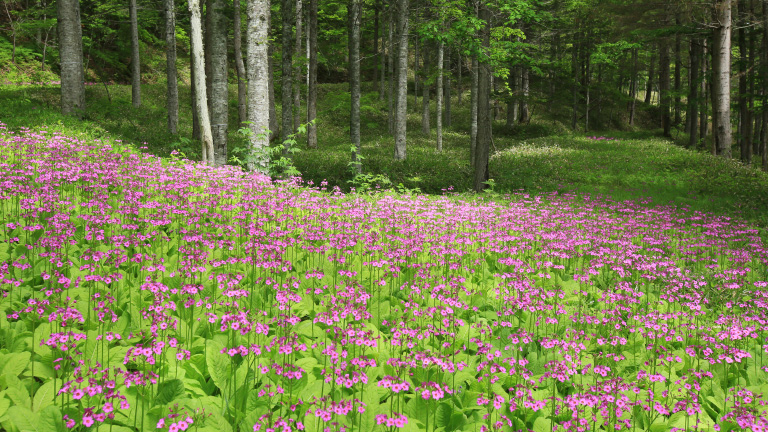
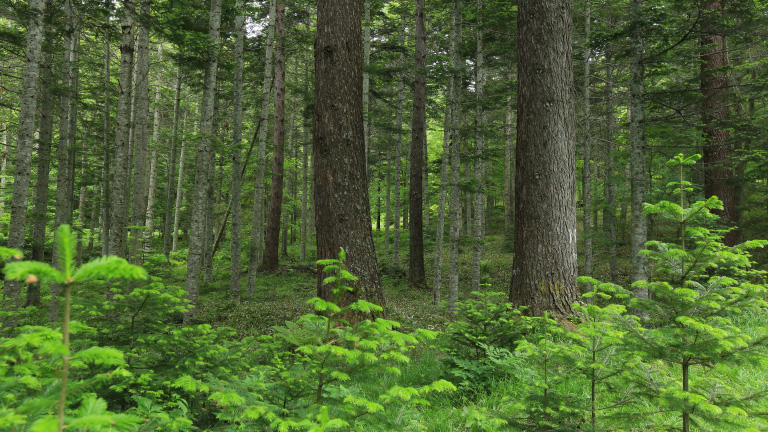
Ishii Forest, located in Tokachi-gun, Hokkaido, is a forest that we acquired in August 2011. In 1969 it was entered in the National Agricultural Festival (now the Agriculture, Forestry and Fisheries Festival) as a mixed needle and broadleaf forest, and was the only forest awarded the Emperor's Prize in the Forestry Management category. The forest is still managed in line with management practices from that time. Comprised of "Natural Restoration Forests," "Biodiversity Conservation Forests" ("Water and Soil Conservation Forests"), and "Productive Naturally Regenerated Forests," the 300-hectare forest is unique among the 75 forests we manage. In the "Natural Restoration Forests," and "Productive Naturally Regenerated Forests," we have continued the same management policy of the previous owner, extending the period of main cutting of the forest to the long term, etc., and practicing a long-cut non-thinning operation that can continuously demonstrate the forest's public benefit value. In addition, we aim to eliminate planting work, which is a major cost in Japan's forestry industry, by using natural regeneration, a method that uses the power of nature to grow young trees and regenerate the forest as much as possible. Ishii Forest is therefore a sustainable forestry model from a cost standpoint as well.
Through such management practices, Ishii Forest is a particularly important site for biodiversity conservation among all mountain forests, and provides ecosystem services such as water recharge, soil conditioning and retention, carbon sequestration, and other regulating and maintenance services, in addition to supply services such as timber and water. This makes Ishii Forest a site of particular importance with positive nature-related impacts.
In this regard, evaluating the public benefit functions that can be achieved through sustainable forest management, particularly using the LEAP Approach, is crucial for managing Mitsui's Forests, including other mountain forests. This approach enables visualization of the effects of managing Mitsui's Forests and understanding nature-related positive impacts.
[Evaluate] Dependencies and impacts
For Ishii Forest and its surrounding areas, we have hypothesized and tested scenarios of what the environment would be like if we had not introduced our forest management methods after acquiring the forest in 2011. We then used these scenarios as a reference for verifying the impact of our management methods.
Overview
- Out of the many functions possessed by forests, environmental assets and ecosystem services are subject to analysis under the LEAP approach. Therefore, we have selected the five assessment items shown in the table below as items that we consider to be quantitatively assessable. We have attempted to quantify the public benefits offered by Ishii Forest through a comparative analysis. This involved comparing the continuous implementation of the forest management methods currently in use at Ishii Forest with scenarios involving forest management using other methods.
- Through this quantification, we have confirmed the public benefits created by conserving the diverse ecosystems (environmental assets), carbon sequestration effects, soil retention effects, and water recharge effects (ecosystem services) of Ishii Forest using the sustainable forest management methods we practice.
| Biodiversity assessment | Assessment of the current status of biodiversity in Ishii Forest and its surrounding areas in terms of conservation priorities and distribution of species (in cooperation with Think Nature Inc.) |
|---|---|
| Impact of forest management on biodiversity | Assessment of the impact of appropriate forest management methods on the number of living species (in cooperation with Think Nature Inc.) |
| Soil retention effects | Assessment of soil loss volumes for both forested and unforested land based on the Universal Soil Loss Equation (USLE), a widely-used formula for predicting soil loss (in cooperation with MS&AD InterRisk Research & Consulting, Inc.) |
| Carbon sequestration effects | Assessment of the amount of carbon fixation by trees calculated using the Forest Agency’s Carbon Dioxide Absorption and Fixation Visualization Calculation Sheet and assessment of the amount of carbon sequestered by forested soil using the difference in sediment yields between forested and unforested land to calculate the amount to which forested land reduces carbon release from soil runoff, including the amount of carbon released in erosion caused by soil runoff (in cooperation with MS&AD InterRisk Research & Consulting, Inc.) |
| Water recharge effects | Assessment of recharge functions enabled by forest management based on a visualization of the water cycle in the target area (in cooperation with Geosphere Environmental Technology Corp.) |
Biodiversity assessment
[Action] Assessment of the current state of Ishii Forest and its surrounding area
[Results]
Using the Japan Biodiversity Mapping Project, a project created by Think Nature Inc. that provides big data related to biodiversity, including information on the distribution of a wide range of organisms, we checked what parts of the target area have been designated as nature reserves and the current conservation priorities based on information on the distribution of species. As a result, we confirmed that the conservation priority level of biodiversity in Ishii Forest is higher than in surrounding areas.
[Distribution of vascular plant species]
The median number of vascular plant species in Ishii Forest is five species higher
than in the planted forests surrounding it and roughly the same as in the natural forest located to the
East.
Representative species include coniferous species that make up planted forests, such as Japanese
larch and Sakhalin fir, broad-leaf species such as Japanese elm and Japanese white birch, and herbaceous
species such as Japanese pachysandra, Japanese primrose, and Sasa nipponica.
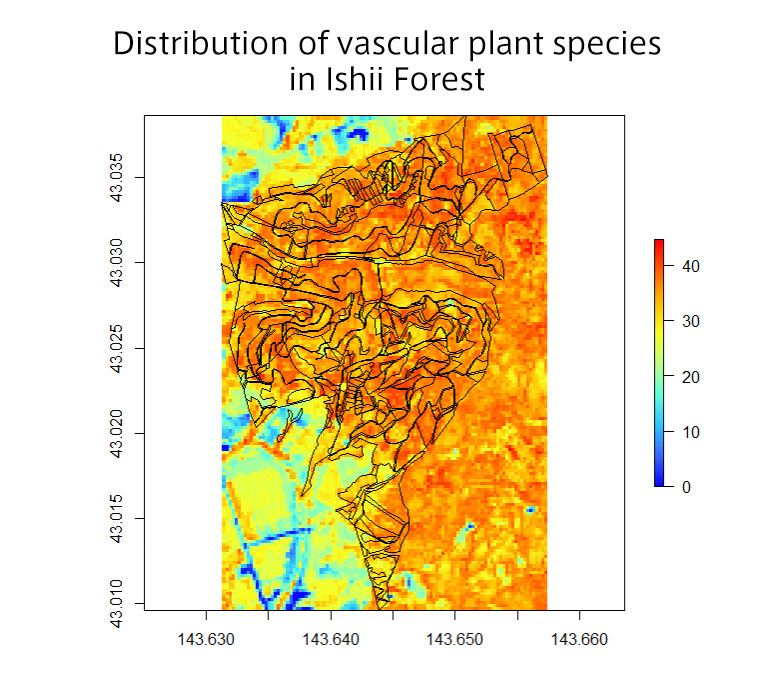
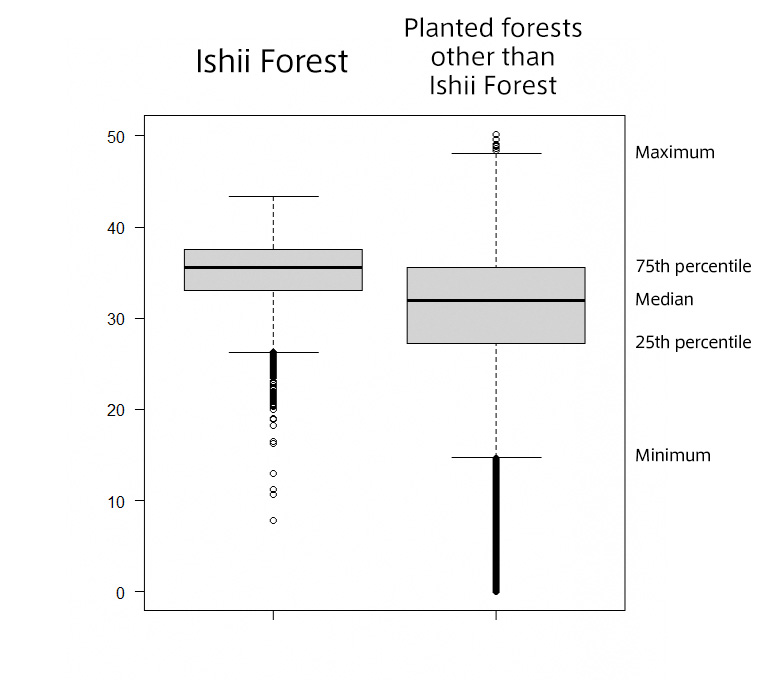
© Think Nature, Inc. 2023, All Rights reserved.
[Distribution of mammal species]
The median number of mammal species in Ishii Forest is one species higher than in
the planted forests surrounding it.
Representative species include the brown bear, Yezo sika deer,
Sakhalin fox, and Ezo flying squirrel.
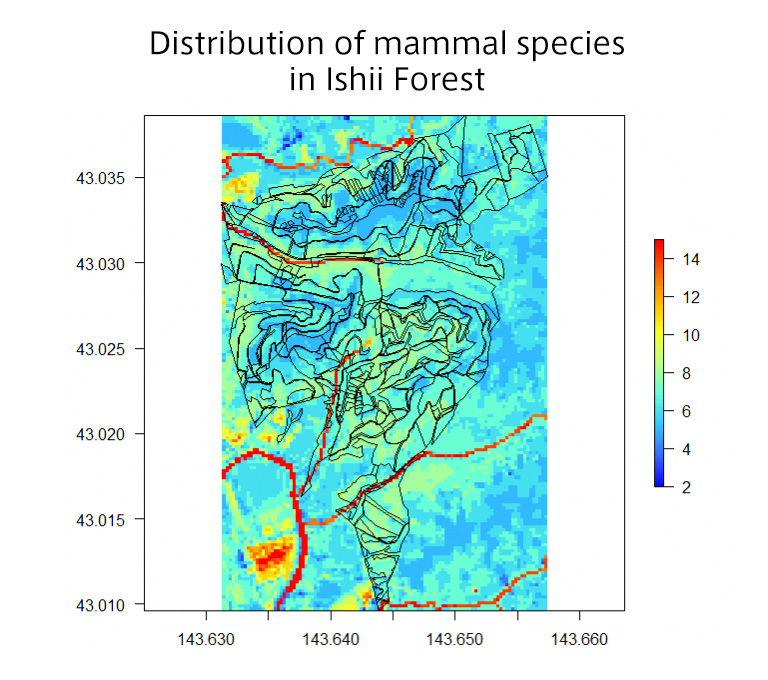
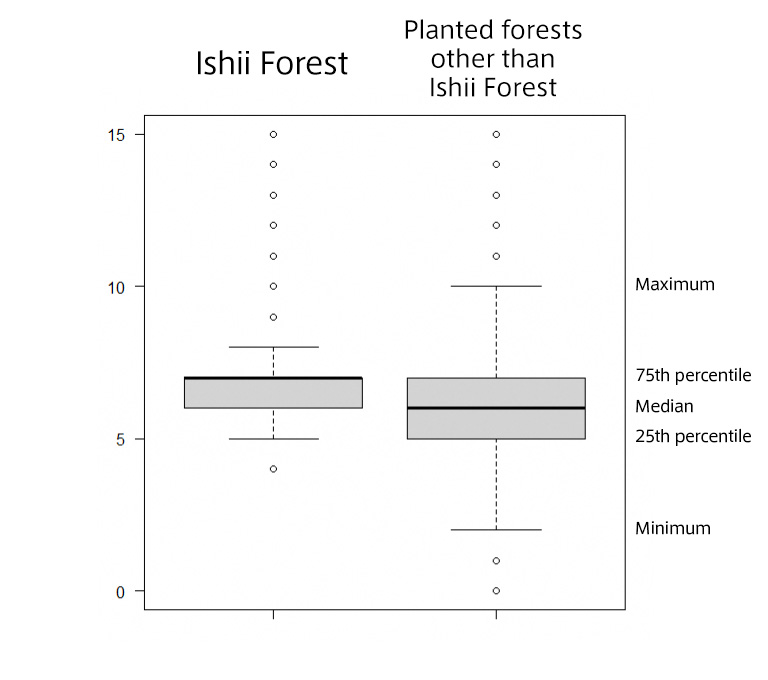
© Think Nature, Inc. 2023, All Rights reserved.
Impact of forest management on biodiversity
[Action] Assessment of the impact of appropriate forest management methods on the number of living species
[Results]
We carried out analyses and assessments based on the three scenarios shown below and then compared the outcome of each of the scenarios in terms of biodiversity conservation. Note that we set 2011, the year we acquired Ishii Forest, as the base year, but analysis was carried out using data from 2009, the closest year to this base year that we were able to obtain data for.
| Scenario | Premise |
|---|---|
| Current management | Continuous implementation of the forest management methods currently in use at Ishii Forest, including a long-rotation system that avoids clear cutting, enabling the forest to sustainably demonstrate its public benefits. |
| Unmanaged forest | No forest management methods implemented. Assumes that Ishii Forest was not designated as a privately-owned protected area and development therefore progressed at the same rate as in other privately-owned land in the surrounding area. |
| Clear-cutting | Clear-cutting carried out to obtain timber. Assumes that clear-cutting was carried out on 50-year-old trees, in line with the Hokkaido Regional Forest Office’s standard of 50 years for the cutting of planted Sakhalin firs, followed by replanting. |
The forestry management we are implementing at Ishii Forest is classified as non-clearcut / retention forestry. This means that in planted forests, cutting is carried out in a way that retains the healthiest broad-leafed trees, enabling the forest to replenish its natural capabilities as much as possible without the need for clear-cutting. The use of this management method at Ishii Forest has curbed the decline in forested area compared to land with different designations in the surrounding area, and prevented development for non-forestry purposes(such as agriculture).
From 2009 to March 2024, 100% of Ishii Forest’s area remained forested.
In contrast, more than 20% of surrounding forest land outside of protected areas was cleared. Therefore, assuming that Ishii Forest did not become managed forest and was developed in a similar way to surrounding land, it is highly likely that over 20% of its area would have been deforested.
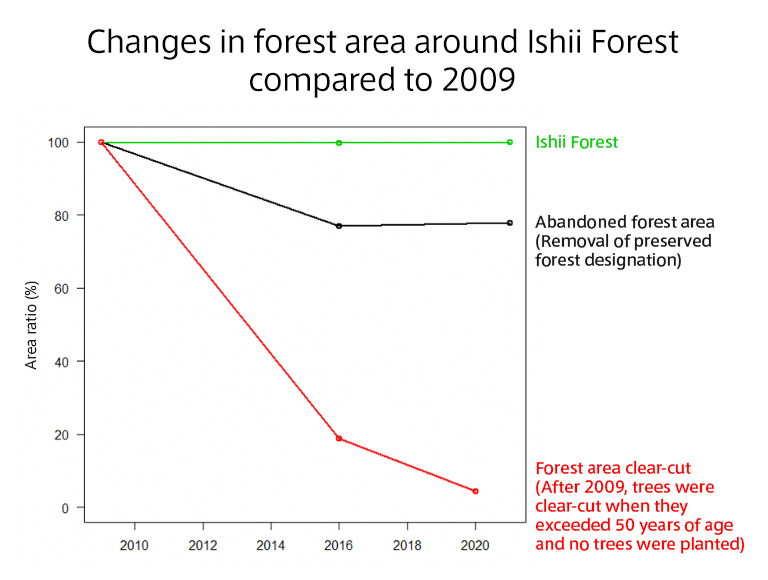
© Think Nature, Inc. 2023, All Rights reserved.
Dividing the Ishii Forest into a grid of 20m x 20m squares, the average number of plant species for the entire forest is estimated from the number of species distributed in each grid.
The analysis showed that Ishii Forest contains a greater number of vascular plant species than surrounding planted forests, and roughly the same as neighboring natural forest. It also found that under the current management scenario, the number of species grows or stays the same, more than 14-30% greater than the number under the other two scenarios.
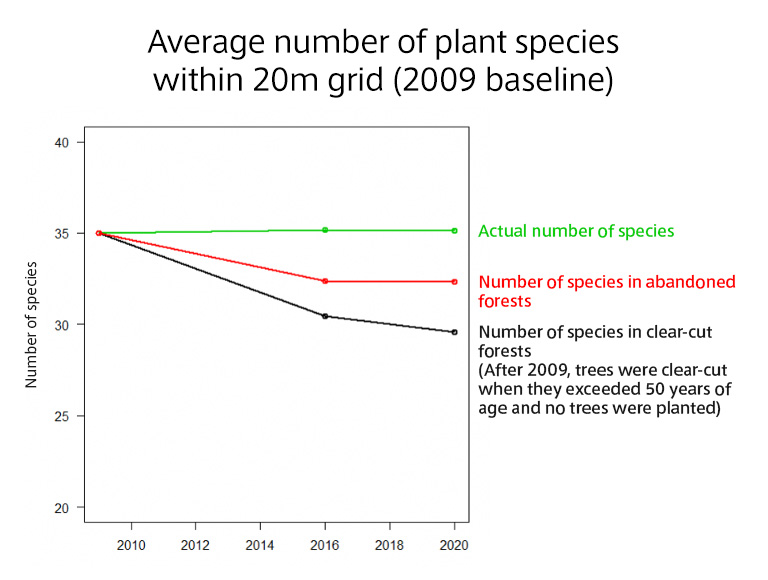
© Think Nature, Inc. 2023, All Rights reserved.
Trends in the number of mammal species were also analyzed in a similar manner. Under the current management scenario there was minimal change while under the clear-cutting scenario, the total clearing of trees aged 50 years or older led to a considerable 13% reduction in the number of species. The unmanaged forest scenario produced a decline of 9%.
Overall, the results for the current management scenario show that the retention forestry method enables biodiversity to be maintained at the same levels as natural forests.
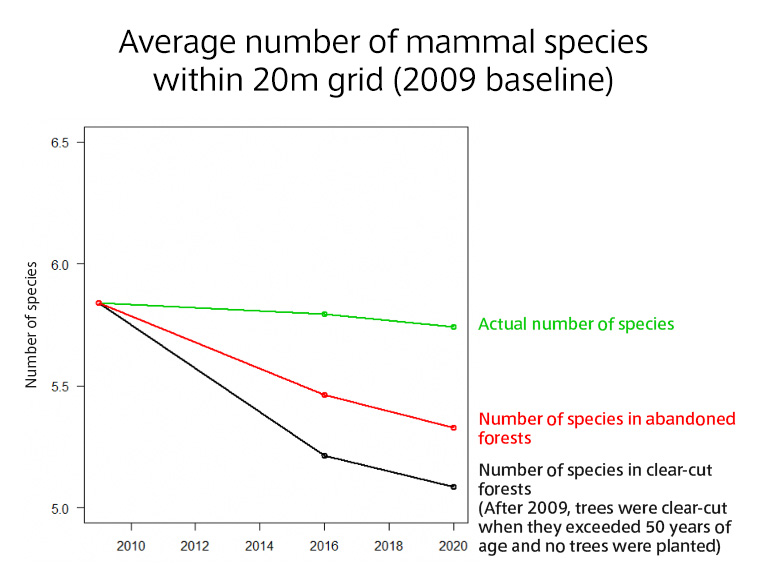
© Think Nature, Inc. 2023, All Rights reserved.
Soil retention effects
[Action] Assessment of the quantity of soil loss in cases of forested and unforested land
We assessed the quantity of soil loss in cases of forested and unforested land based on the Universal Soil Loss Equation (USLE)*, a widely-used formula for predicting soil loss.
- Developed primarily by the United States Department of Agriculture and adopted as a standard for agricultural land conservation in the U.S.
- Recommended as an appropriate method in official land improvement guidelines pertaining to agricultural development in Japan
- Estimates average annual soil loss based on rainfall characteristics, soil characteristics, slope length and steepness, surface vegetation, and effects of conservation activities (does not estimate soil loss volumes for each type of rain)
* Universal Soil Loss Equation
[Results]
This involved analysis and assessment based on two scenarios, a current management scenario and a deforestation scenario.
| Scenario | Premise |
|---|---|
| Current management | Continuous implementation of the forest management methods currently in use at Ishii Forest, including a long-rotation system that avoids clear cutting, enabling the forest to sustainably demonstrate its public benefits. |
| Deforestation | Deforestation leads to the area becoming bare ground. |
| (t/year) | Current management scenario | Deforestation scenario |
|---|---|---|
| Volume of soil loss | 111 | 22,165 |
We found that the conservation of Ishii Forest reduced the annual volume of soil loss in the area to just 0.5% of the potential loss. Soil loss has a huge impact on the natural environment, including damaging water recharge functions, reducing water quality, and destroying ecosystems, but the analysis showed that forest management can mitigate this impact.
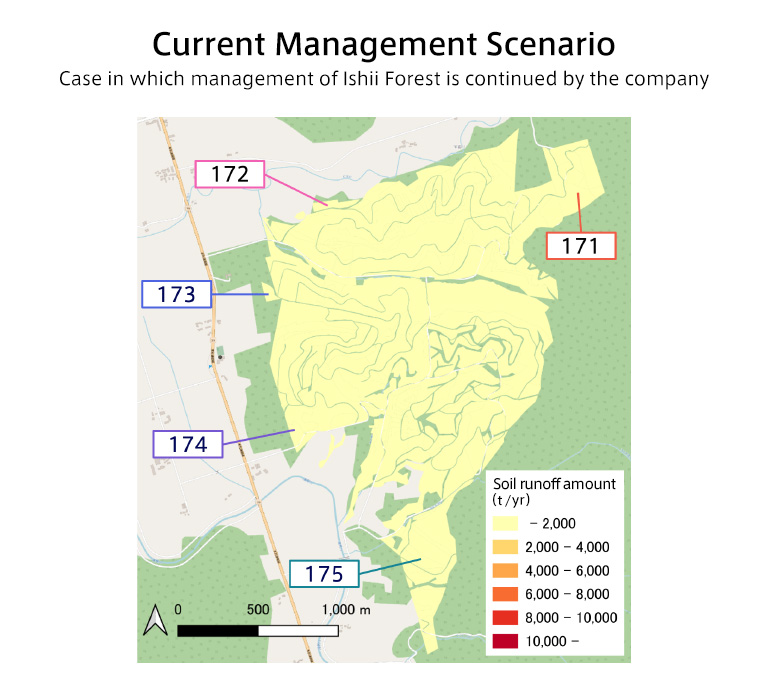
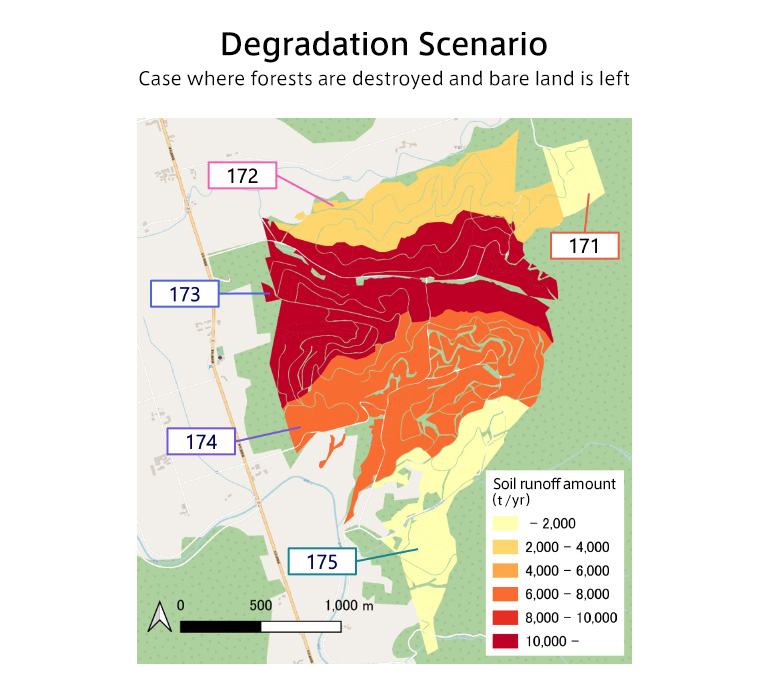
Source: MS&AD
InterRisk Research Institute, Inc.
Background map provided by OpenStreetMap
Carbon sequestration effects
We gained an overall assessment of the annual amount of carbon fixation at Ishii Forest by combining two calculations: 1) the amount of carbon absorbed by trees (carbon fixation by trees) and 2) the amount of carbon release prevented by curbing soil runoff (carbon sequestration by forested soil).
[Action] 1.Carbon fixation by trees
Assessment of the amount of carbon fixation calculated using the Forest Agency’s Carbon Dioxide Absorption and Fixation Visualization Calculation Sheet
[Results]
We calculated the amount of carbon dioxide absorbed by the forest based on location, tree species, tree age (using five-year intervals), area, tree density, tree height, and average diameter.
We estimated that Ishii Forest can absorb about 292 tons of carbon per year (equivalent to about 1,072 tons of CO2 per year). This is roughly the same as the annual emissions generated by 391 regular households.
Ishii Forest contains many Japanese larches and Sakhalin firs, and in regard to carbon absorption and fixation, we know that the peak carbon absorption volume is reached at around 11 to 15 years old for Japanese larches and at 16 to 20 years old for Sakhalin firs. We continue to carry out forest management practices that promote forest renewal by appropriately thinning forests that have reached an advanced stage of maturity. This is believed to be effective in maintaining carbon sequestration effects.
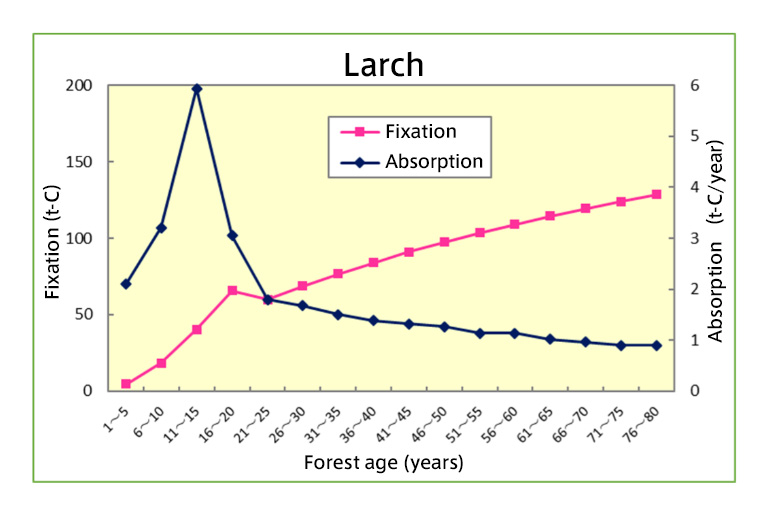
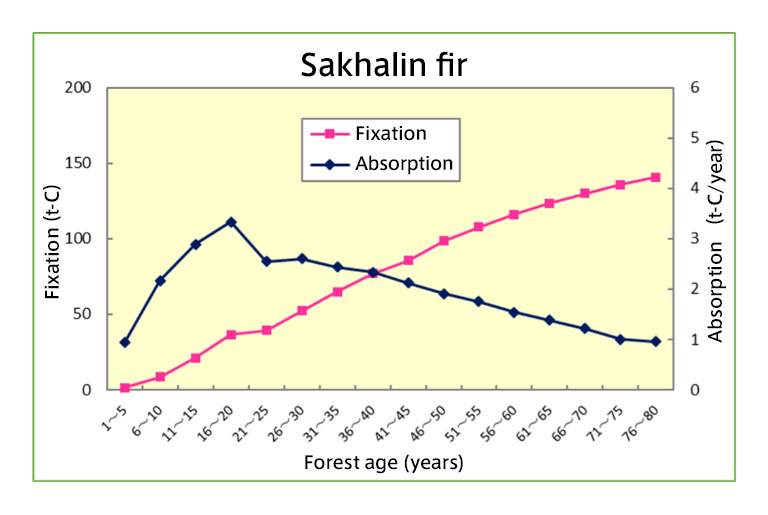
Source: MS&AD InterRisk Research & Consulting, Inc. edit of data from the Hokkaido Regional Forest Office’s website (https://www.pref.hokkaido.lg.jp/sr/srk/81225.html)
[Action] 2.Amount of carbon release prevented by curbing soil runoff
Assessment of the amount of carbon sequestered by forested soil by using the difference in sediment yields between forested and unforested land to calculate the amount to which forested land reduces carbon release through soil runoff, including the amount of carbon released in erosion caused by soil runoff
[Results]
We calculated the volume of carbon sequestered in soil by multiplying the volume of soil retained through curbing runoff by the carbon content of one ton of soil. According to Forest Research and Management Organization’s Hokkaido Research Center, the brown forest soil that comprises most of Ishii Forest’s area contains 140 tons of carbon per hectare at depths of up to 70 cm. Based on this, we made the assumption for this analysis that one ton of brown forest soil contains 0.025 t-C.
We found that the amount of carbon retained in soil by preventing runoff through forestry management was 551 tones per year, equivalent to a reduction of about 2,020 tons of CO2 emitted through runoff per year.
Although it is difficult to considerably raise the amount of carbon sequestered by trees using the retention forestry method being implemented at Ishii Forest, it can prevent soil runoff, particularly compared to clear-cutting, which severely destabilizes the ground, and therefore enables carbon to be retained within the soil for long periods.
| (t-C/year) | Carbon fixation by trees | Carbon sequestration by forested soil |
|---|---|---|
| Volume of carbon absorbed (equivalent in t-CO2) |
292(1,072) | 551(2,020) |
Water recharge effects
[Action] Assessment of recharge functions enabled by forest management based on a visualization of the water cycle in the target area
[Results]
Water recharge functions demonstrated by forests include flood mitigation, water resource accumulation, and water purification. In recent years, abnormal weather patterns have made the flood mitigation functions demonstrated by healthy forests more important than ever for environmental conservation.
In this analysis, we defined the water recharge volume as the volume of water passing downward through the ground surface. This was calculated based on soil infiltration capacity (the ability of forest soil to allow infiltration by rain) and the amount of aboveground evapotranspiration (calculated using a forest evapotranspiration model that takes into account factors such as precipitation volume, air temperature, global solar radiation, tree species, tree height, and forest density). For the purposes of this study, only the average recharge volume (the volume of water passing downward through the ground surface) was considered, and we did not consider temporal changes over the last 10 years. Therefore, conditions such as the permeability of the topsoil will affect the values.
For each of the three scenarios shown below, we carried out a quantitative assessment of water recharge volumes by simulating the water cycle. The difference in recharge volumes for each scenario was quantified based on the current management scenario. (Note that this analysis does not quantify all of the other water source recharge functions of the forest, such as flood runoff reduction during heavy rainfall events by controlling sediment runoff and storing groundwater.)
| Scenario | Premise |
|---|---|
| Current management | Continuous implementation of the forest management methods currently in use at Ishii Forest, including practicing a long-cut non-thinning operation that can continuously demonstrate the forest's public benefit value. |
| Pre-management condition | The condition Ishii Forest was in when first acquired. |
| Clear-cutting | Clear-cutting carried out to obtain timber. Assumes that 51% of Ishii Forest area has been developed since 1977, the same as in the surrounding area, and that clear-cutting of the developed area has led to soil loss. |
A comparison of the current management and pre-management condition scenarios showed that forest management methods such as tree thinning yield a positive effect equivalent to about 71,800m3 of water per year. A comparison of the current management and clear-cutting scenarios showed that preventing a decline in surface water permeability due to soil loss enables the retention of about 384,400m3 of water per year.
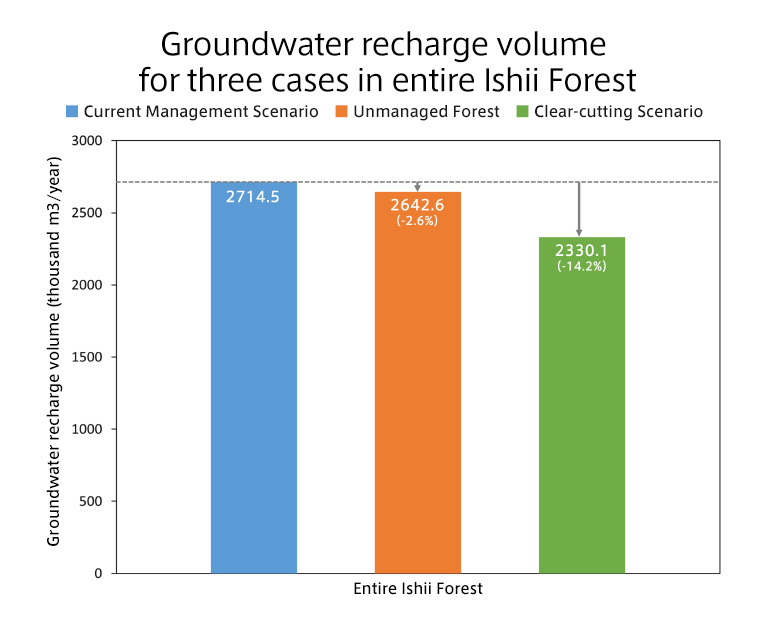
| (m3/year) | Current management | Pre-management condition | Clear-cutting |
|---|---|---|---|
| Difference in water recharge volume | - (Base) | - 71,800 | - 384,400 |
In addition to the volume of water recharge maintained by Ishii Forest, which was quantitatively analyzed in this study, it is generally considered that deforestation results in long-term soil loss. This then leads to a decrease in infiltration capacity, reduced water recharge volumes, increased flood flow volumes, and a decline in the volume of groundwater reaching downstream areas.
[Assess] Risks & opportunities
The following are potential opportunity aspects of "Mitsui's Forest" that can be assumed based on this assessment.
LEAP LEAP for Company-owned Forests - Potential Opportunity Aspects
-
Soil runoff
- Suppress soil runoff
- Conservational logging can effectively suppress soil runoff compared to clear-cutting which severely disturbs the ground surface
- Suppression of soil runoff
- Prevention/reduction of land slips
- Maintenance of ground water recharge volume
-
Carbon fixation/Suppression of carbon release
- Long-term retention and fixation of carbon from two perspectives: absorption of carbon by trees and control of carbon runoff from the soil
- Absorption of carbon dioxide and emission of oxygen
- Long-term retention and fixation of carbon
-
Groundwater recharge
- Maintenance of groundwater recharge volume through appropriate management of forest land
- Improvement of groundwater recharge (71,800m3 per year)
- Stable supply of water resources
- Maintenance of water circulation in watershed areas
- Mitigation of flooding through improved water retention
-
Biodiversity
- Reduce deforestation and development
- Maintain essentially the same level of biodiversity as natural forests through conservational logging
- Conservation and protection of forest ecosystems and habitats
- Opportunities for more proactive ecosystem restoration and enhancement (Nature Positive)
Other potential effects
- Preservation and protection of local ecosystems and natural landscapes (also to counter regulatory risks related to residual forest coverage and revegetation rates)
- Cultivation of environmental conservation awareness through ecotourism involving education and local communities
- Maintenance of water quality in watershed areas (lower release of nitrogen and phosphorus compared to agricultural fields)
- Sustainable supply of wood resources
In the TNFD sector guidance, forest-related risks are defined as below.
All
Mitsui's Forests are FM certified, and it has been shown that FSC® assessment items are closely aligned with the
identification and assessment of such forest-related risks, as shown with the LEAP Approach analysis of
Minamisanriku FSC® certified forest conducted by WWF Japan. We will continue to address risks by maintaining
and renewing FM certifications.(The FSC® trademark license code of Mitsui & Co., FSC®C057355)
| Risks | Description of risk | |
|---|---|---|
| Physical Risks | Acute Risks | Ecosystem degradation and biodiversity loss potentially reducing yields |
| Increased outbreaks of pests and diseases affecting forest health | ||
| Damage to infrastructure due to increased risk of landslides during floods and storms resulting from clearing of forests and vegetation | ||
| Decreased ecosystem services, increased exposure to and impact from extreme weather events | ||
| Loss of key species | ||
| Chronic Risks | Increased water scarcity due to climate change | |
| Changes in climate and natural conditions affecting the resilience of tree species and the ecosystems in which organisms function | ||
| Transition Risks | Policy | Tightening of regulations on activities with significant impacts on nature (e.g., mining permits for natural resources) |
| Regulatory changes aimed at nature-positive outcomes | ||
| Strengthening of reporting requirements | ||
| Market | Changes in customer values and preferences | |
| Reputation | Shift in customer sentiment away from brands with low awareness of nature management | |
| Technology | Transition to more efficient, cleaner, less nature-intensive technologies | |
| Lack of access to quality data hindering evaluation of natural associations | ||
In the TNFD sector guidance, nature-related opportunities associated with forests are
defined as below.
In order to maintain the opportunity aspects identified in this analysis, we will
continue non-clearcut / retention forestry operations at Ishii Forest, and at the same time we will also
implement forest management practices at our other forests to capture new opportunities based on our findings.
| Opportunities | Description of Opportunities |
|---|---|
| Resource Efficiency | Transition to processes that positively impact nature (e.g., restoration, reduction of pollution) |
| Diversification of nature-related resources | |
| Adoption of solutions rooted in nature | |
| Products & Services | New business model activities that have a positive or reduced impact on nature |
| Development of new products utilizing wood materials in place of non-renewable environmentally hazardous materials | |
| Markets | Access to emerging markets |
| Capital Flow and Financing | Access to nature-related green funds, bonds, and loans |
| Utilization of incentives for suppliers | |
| Reputation Capital | Collaboration with stakeholders |
| Actions that increase positive brand perception | |
| Ecosystem protection and restoration | Restoration, conservation, or protection of critical ecosystems or habitats, either direct or indirect (e.g., funding partners, advocacy) |
| Implementation of site-based nature-based solutions | |
| Investment in multi-stakeholder actions at land/jurisdictional level | |
| Sustainable use of natural resources | Transition to processes that have a positive impact on nature |
| Reuse of natural resources and increase in recycling | |
| Adoption of natural solutions in service and product lines | |
| Product and service certifications | |
| Actions that bring about positive change in the supply of natural resources |
[Prepare] To respond & report
Through the LEAP Approach, we have found that, in terms of biodiversity conservation
and other aspects, positive nature-related impacts have been realized in Ishii Forest. Mitsui and Mitsui Bussan
Forest will continue sustainable forest management to ensure that this positive impact can continue to be
achieved.
In addition, while Ishii Forest was identified as a particularly important site for this
particular analysis, we are also working to conserve biodiversity at our other forests through sustainable
forest management on a forest-by-forest basis. Examples of biodiversity conservation measures in Mitsui's
Forests are as follows.
Kyoto/Kiyotaki Forest: Registration as Nature Harmony Site
A Nature Harmony Site is an area certified and recognized by Japan’s
Ministry of the Environment as "an area where biodiversity is being conserved through private sector
initiatives, etc." Certified areas (excluding overlaps with protected areas) are registered in an
international database as "OECM (Other Effective area-based Conservation Measures)." By registering
Company-owned forests as Nature Harmony Sites, we hope to contribute to the international goal of 30 by 30
(a goal related to natural capital that aims to designate 30% of Earth's land and ocean area as protected
areas by 2030).
One of Mitsui's Forests, the Kiyotaki Forest in Kyoto, provides firewood for the Gozan
Okuribi (Bonfire Festival) and Kurama no Hi-Matsuri (Kurama Fire Festival), which are traditional events in
Kyoto, as well as red pine and Japanese azalea used as materials for torches. In 2023, we officially
registered the Kiyotaki Forest as a Nature Harmony Site, having the values of "a place where ecosystems
characteristic of secondary natural environments such as Satoyama exist (Value 3 in the criteria for
certification as a Nature Harmony Site) and "a place that provides natural resources used for traditional
local culture such as traditional crafts and events (Value 5 in the criteria for certification as a Nature
Harmony Site).

Kyoto: Gozan Bonfire
In Hokkaido's forests, damage caused by the Hokkaido red-backed vole, which gnaws bark and roots, has become a serious issue. With consideration for environmental impact, we are now turning our attention to owls as a measure that does not require chemicals. We have created and installed nesting boxes suitable for owl breeding and habitat in our forests, and regularly monitor their use.
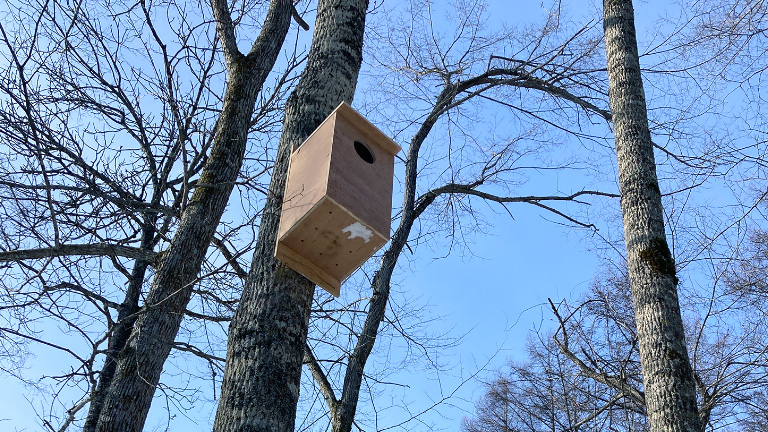
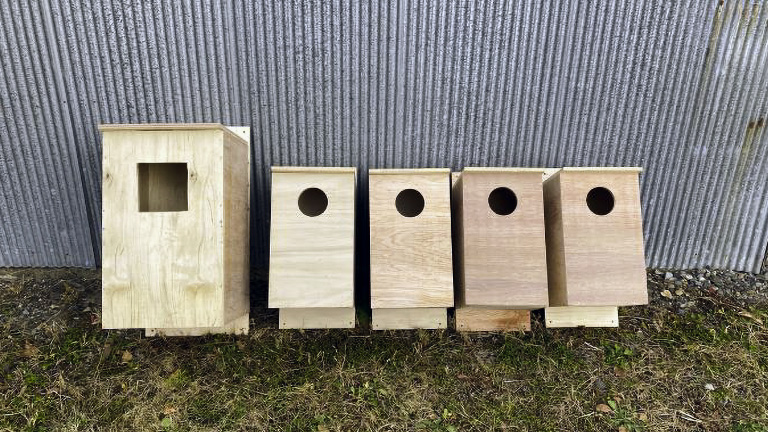
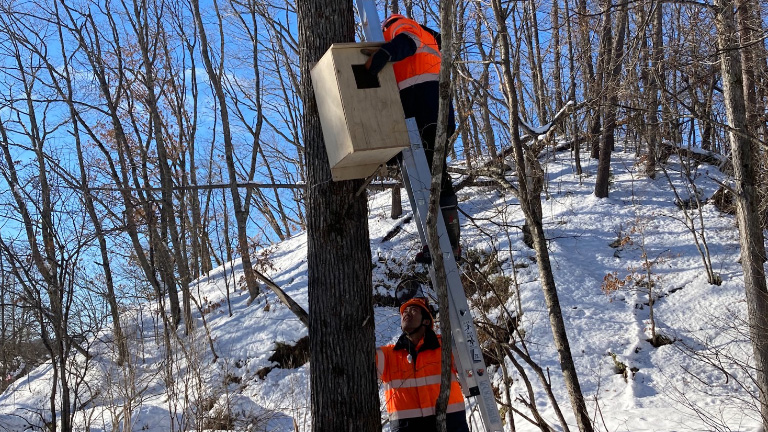
Hokkaido: Installation of owl nesting boxes

